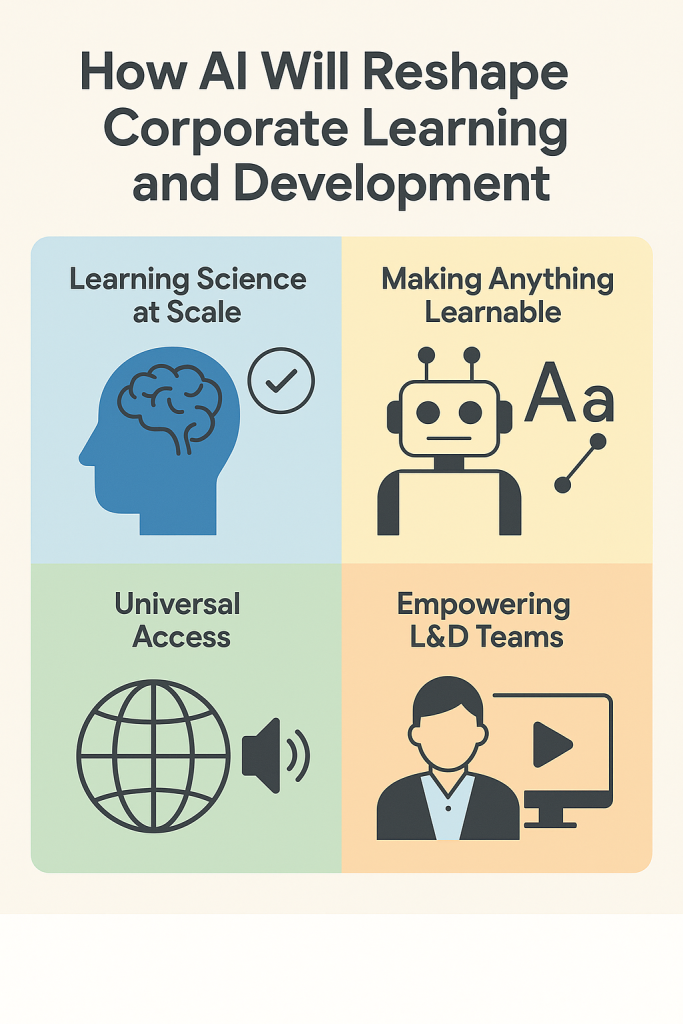Google’s 2025 report, AI and the Future of Learning, warns that global learning outcomes are declining while the need for skilled talent is rising. The report argues that AI will reshape how people learn—but only if it is grounded in proven learning science. This article summarizes Google’s findings and explains what they mean for L&D inside organisations.
Source referenced throughout:
Google (2025), AI and the Future of Learning.
Why This Report Matters for Organizations
Google confirms three interconnected trends:

- Learning outcomes have dropped sharply worldwide.
PISA scores in mathematics and reading show the steepest decline in two decades. - The world is short of educators.
UNESCO projects a deficit of 44 million teachers by 2030. No organisation—corporate or educational—is immune to this shortage. - Learning systems are not keeping pace with the complexity of work.
Traditional approaches cannot scale to meet modern skills demands.
This is the backdrop against which Google positions AI not as a silver bullet, but as infrastructure—a set of tools that, if used wisely, allows us to embed the science of learning into daily practice at scale.
Google’s Four Key Opportunities for AI in Learning
Google identifies four major opportunities created by AI. Here’s what each one means for corporate L&D.
1. Learning Science at Scale
AI can:
- weave retrieval practice into assessments
- build spaced repetition into learning sequences
- generate active learning questions
- personalise feedback in real time
This means L&D teams can finally design effective learning without needing to manually build every pedagogical element themselves.
Implication:
We can stop reinventing content and start architecting learning systems rooted in cognitive science.
2. Making Anything Learnable
AI can:
- simplify complex knowledge
- adjust explanations to skill level
- contextualise examples to role, industry, or domain
- generate multiple representations of the same concept
For organisations, this bridges a fundamental gap: the distance between abstract knowledge and day-to-day application.
Implication:
We move from “content delivery” to “conceptual understanding”—the true driver of performance.
3. Universal Access
AI removes long-standing barriers by:
- translating content instantly
- adapting materials for literacy or accessibility needs
- converting formats (text → video, video → quizzes)
- supporting mobile-first, deskless learning
Implication:
Every employee—regardless of location, role, or language—can access high-quality learning.
This is especially critical for multi-site organisations, frontline teams, and the ADRIA region’s multilingual workforce.
4. Empowering Educators and L&D Teams
Google is explicit: AI should free educators, not replace them.
AI can automate:
- lesson planning
- content scaffolding
- enrolment and reminders
- assessment generation
- feedback cycles
Implication:
L&D moves away from administrative work and towards high-value work:
consulting, capability building, system design, and impact measurement.
What This Means for Corporate L&D Teams
If we read between the lines, Google’s report signals a major shift in how organisations should think about learning:
1. L&D must evolve from content creators to learning system designers.
The value is not in building slides or SCORM; it’s in designing learning ecosystems that apply evidence-based principles.
2. AI should be used to scale learning science, not shortcuts.
The question is not “How can AI generate more content?”
The question is “How can AI help learners think more deeply?”
3. Organizations need unified learning infrastructure.
Fragmented tools—PDFs, manual training logs, separate authoring tools, disconnected LMS platforms—are structurally incapable of delivering what Google describes.
4. The competitive advantage will come from operationalizing learning science.
Not from buying AI.
Not from using “smart” tools.
But from systematically applying what we already know about how humans learn.
Takeaway
Google’s report is not a celebration of AI. It is a call to redesign our learning systems using the best evidence available.
The organisations that will thrive over the next decade will be those that:
- build learning ecosystems grounded in cognitive science
- use AI deliberately and transparently
- reduce administrative burden on L&D teams
- personalise learning without sacrificing rigour
- design for understanding, not consumption
Because in the end, the greatest opportunity is not the technology itself. It is what the technology allows us to finally deliver: effective, equitable, engaging learning at scale.